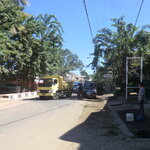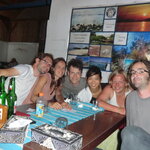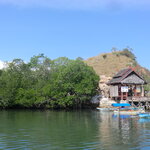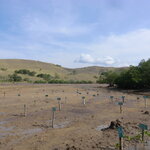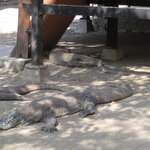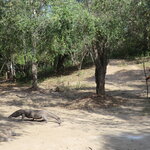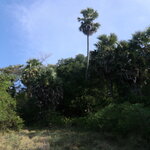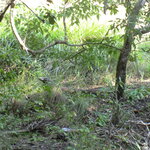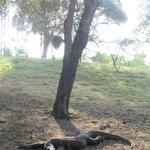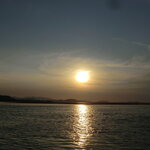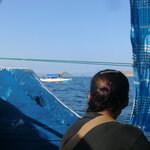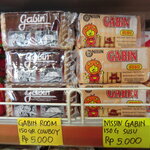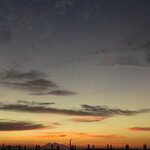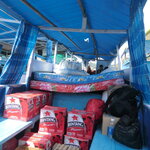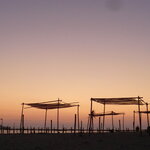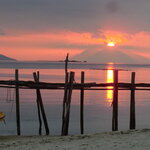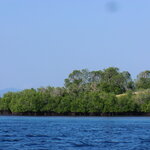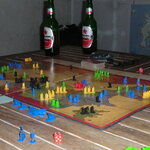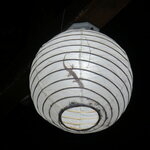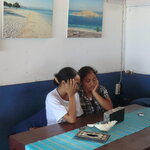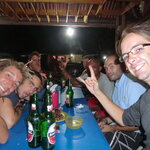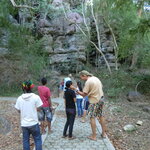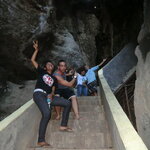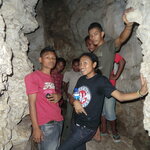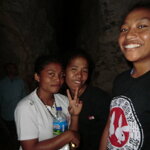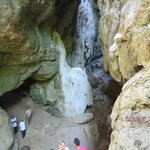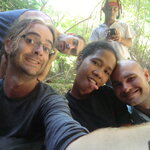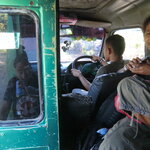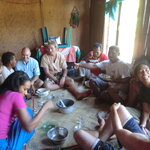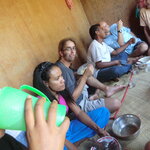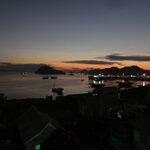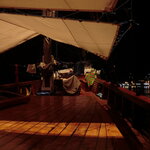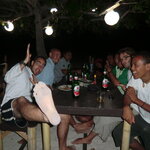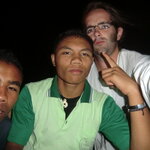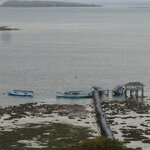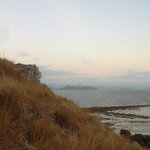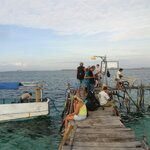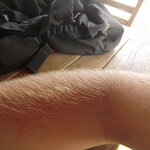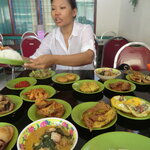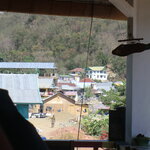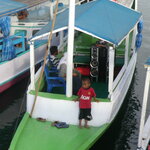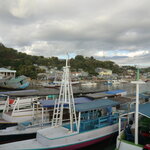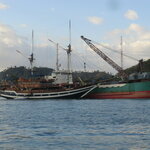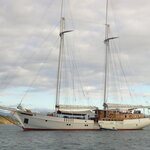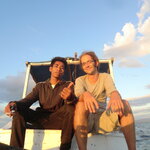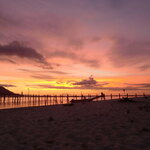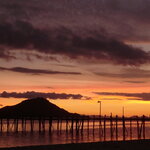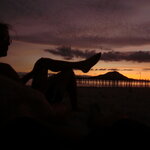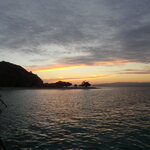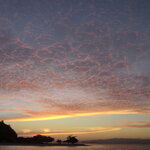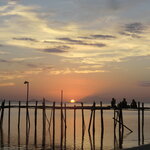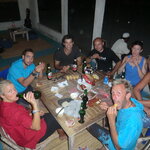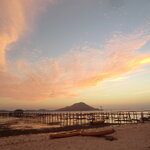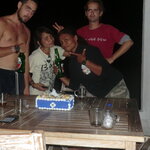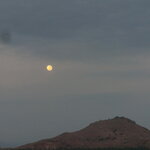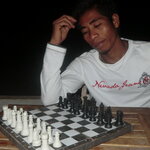_Une fois n'est pas coutume, un article en anglais. Je rappelle qu'il y a un tradcuteur Google en haut à droite du blog. Si je termine la traduction, je mettrais à jour l'article._
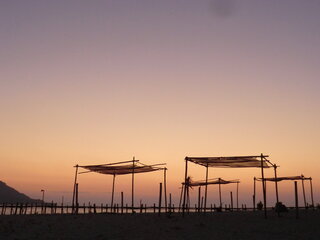
I'm since nearly two months now on a small island in the middle of Indonesia, below the Equator, near Komodo island, where the famous "dragons" are leaving. This place is a bit remote, although not that much when you look on a map. It takes a good hour to come from the nearest city, which is itself deserved by a small airport with a single track and shrubberies at the entrance. Labuan Bajo is a small city, maybe a town, with a few paved roads, somehow colonized by a range of Italian investors who are holding the major "venues" of the place, restaurants and hotels, although a few of those are Indonesian owned. The streets are a bit dusty, and when you manage to escape the city "center", you end up in a nice country side with houses made of wood and people eating right on the floor.
To go to the island, you need to catch the only boat of the day at noon, which tends to leave usually somewhere between 12h30 and 17h (it's always on time, it's just your watch which is set too early, of course), hoping it's going to be high tide in the harbor otherwise you end up jumping on the narrow, front part of the boat from a good metre above the deck, the boat gently rolling with the dirty waves of harbor water (which doesn't keep Indonesians to jump into the water to get a missed moray line or a stucked anchor. Iiiih shiver) Anyway, and then, the captain lifts up a few wooden boards to open the belly of the boat, and with a handful of movements known only to himself and a few trusted companions, he starts the engine, in a nice "mop-mop" similar to the long-tails of Thailand (not as mop-mopy though.) and the boat makes its way out, passing along all the huge live-aboard boats, all made of wood as everything else here, large and disguised as old, antic sails. There are quite pretty though. Sometimes, you can see some dolphins cruising towards the exit of the harbor, showing their backs for a few seconds before continuing underwater. And then, we are still not really out, since there are a few small inhabited islands protecting the city from the waves, if there are any stronger enough to cause any problems. Here around, everything is quite dry at the moment, yellow grass, dry soil and dust here and there, and when you can see the rocks under the trees, they have a nice red-rusty color, the same as one can find in Yunnan in China and other places in France as well (and probably other places I'm sure...). During and after the rainy season, I heard that things change completely and that everything turns green lush, this must really change completely the landscape from what I'm seeing now. Actually, looking at the picture I took when I just arrived, I realized only now how everything changed in just several weeks, things were much greener already at that time.
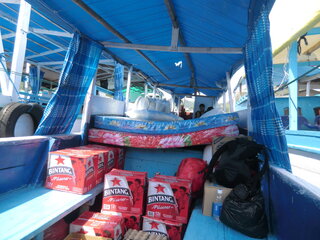
But now, I'm on the sea, and the boat is heading straight to the island, a trip of one hour. We are loaded with goods, my bag and the bags of two other Austrian guys, boxes of Bintang, "Indonesian's most favorite beer", some big bottles of water and jerry cans of gas, and, who knows what else in the back of the boat. On my first trip came with me those two guys and this Singaporean girl with her German husband which are on their way back from Hong-Kong to Munich (well, sort of, Kanawa Island is not really on the way). The long and thin boat moves quite fast, but you need to be careful not to sit all on the same side or it seriously tends to tilt, until the captain from his cabin yells you, covering the sound of the engine, "Hello guys, move right!". The sun hits the sea with full blast, it's past noon at this moment, but the wind is quite fresh and it's really pleasant; hopefully, the boat is covered, although not really from the waves which splash on the sides. Sometimes, dolphins also pass along the boat.
And then, the small island starts to get bigger and bigger, and you can see the bungalows on the side, and the infamous jetty. It was high tide the first time I arrived, and instead of docking to the end of the jetty, we arrived straight in the middle, the sea was high enough for the boat not to run over the coral, but it ended up in a big, long, plastic pipe which is running all along, used to pump the water to the island, without breaking it hopefully. That was my very first Indonesian docking, soon to be repeated.
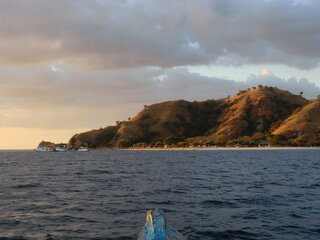
And I'm finally arrived in Kanawa island, a small place stuck between Komodo to the West and Flores to the East, in the middle of Indonesia. I set up a foot on the jetty, traditional piece of Indonesian architecture, made of wood, shaky and rough on the edge, yet still alive despite all it has been confronted to, a hundred meters of craziness from the beach into the sea that I as soon to know by heart, more than 700 wooden boards carefully numerated, a patchwork of beige and brown colors nailed together. The water around is blue turquoise, the sand is white and the beach is running all the way, the sky is deep blue with a few clouds here and there, the sun still shining full blast and the wind refreshing everything. There are definitively worst places to spend a couple of months.
The first thing I did and still do when I arrive on the island is to remove my shoes and forget them until I had to go back to the "main land". I walk around with my bare feet, for the better or worse; most of the ground is made of sand, or dust, which is quite cool to walk on. Here and there some dried grass. And the jetty, with some rusty nails, ready to hurt my skin if I do a bad step. I got cuts and bruises, hit several toes on rocks, walls, or nails, and it takes ages to heal, between the sand and the sea water. My feet have never been so dirty since then, ranging from slightly white powdered to a thin layer of black dust. But I love it and wouldn't put back my shoes for any reasons. All the Indonesians working here have flip-flops most of the time, but I guess it's a privilege which we are not used to have to walk without shoes here.
Quickly when I arrived, I set up my place for sleeping, among all the 20 or so bungalows with nice outdoor showers and the bale-bale, a kind of improved shelter with blinds for walls, I planted the tent which has been given to me under a tree, set up a mattress inside with some sheets, and I was ready to sleep as I hadn't for months. When I tell other guests on the island that I'm sleeping in a tent, since three months, I receive most of the time a mix of pity, disgust, astonishment and admiration (all at the same time), but I actually was really looking for it, a simple place to sleep with a good mattress was all what I wanted to have. For about a month, the only shower which was available to me was the public shower beside the restaurant, normally used for washing off the sea water, I couldn't use soap nor shampoo there and somehow, I managed to survive a month without smelling that much. My hair became quickly a bit messy (yeah, even more than usual), but I guess I could have arranged them if only I had a hair brush anyway.
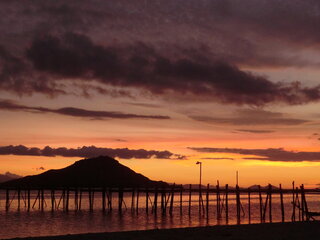
One thing which made me worried a bit before I arrived was the heat. The island is right below the equator, and since I arrived in Vietnam, the weather is kind of hot and wet. I was ready for the worst here, got rid of all my warm clothes in Bali before coming here to make some room in my bag and because I thought it would be damn useless. I now wish I didn't. Since my very first day, even if the sun is super strong, the wind also is and it's actually sometime a bit chilly. I spend most of my day time with only my shorts and no t-shirt but as the sun sets, I long something warmer sometimes. Right now, I'm writing from the hammock on the beach, between two trees and the wind blows really hard and I'm nearly feeling cold, although it's the beginning of the afternoon. When it drops, you really feel all the strength of the sun, though. My skin reacted nicely to those new conditions: it now has a nice golden color (which becomes darker on my feet, mostly due to their dirtiness though), and I'm becoming more and more blond every day, especially on my arms and my head. I can barely see it, I have no mirrors, but I like it, for what it's worth. Every morning, the sun rises around 6 above the mountains of Flores, far away in the distance, and you can see it right from the Eastern beach or walking along the jetty. I'm always awake and out at that time since I arrived here and everyday is colored a bit differently each time. Every evening, the sun sets right off the beach, above the far away mountains of Komodo or Sumbawa, and as in Koh Tao in Thailand, I can just spend the whole sunset on the beach, looking at the colors changing slightly every minutes and the degrade of black to orange to black. Even when there are clouds, the air here is always very clear, the horizon appears like a straight line, Sebayur, the island just in front of Kanawa casts its shadow perfectly at sunset so that we could count each trees popping up above its edge.
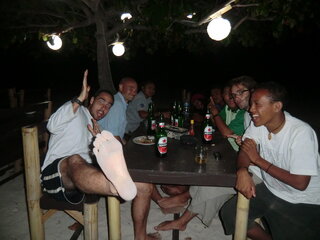
It's a small island but there are quite a number of people working here, all of them Indonesian except some of the people from the dive center. Most of them come from Flores, from one of the big cities of Labuan Bajo, Ruteng, Bajawa or Maumere. Most of them come from high schools specialized in tourism and a few days after I arrived, some numbers of students from one of those schools came here to do their training for 3 months. There are about 30 of those workers here, which seemed quite a lot when I arrived, compared to the number of actual customers (nowadays, there are much more customers here, so it makes much more sense). The "front" people, as I call them, can speak a fairly decent amount of English, profoundly tainted by Indonesian language and are working mostly in the restaurant and at the reception. But there are also many others working in the kitchen, on housekeeping, outdoor maintenance and on the various boats used by the resort or for the dive center. Nearly all of them are quite young, I guess the average age should be around 19 or 20 years old, freshly graduated from school. There are Nita, Getrine, Iwan, Albert, Dancy, Hanna, Defry, Cecil, Ari, Anggie and all the others I can't remember their names. The staff house is near the place I'm staying and you can hear all the day people laughing there, they seem to have quite lot of fun most of the time. Still, beginning of August, one of the Italian owner came on the island to supervise things and probably restore some "order" and as a consequence, several people working here just left before he arrived. It should be said that they like to work at their pace, which is somehow understandable for my point of view when you live in such kind of place. But, for example, the boat captains seem to spend as much time "tuning" (fixing actually) their engines than driving the actual boats, and when things break here, they tend to be fixed... someday... I also managed to learn a bit of Indonesian language, super slowly considering how easy the language can be, but so far, since the beginning of this trip this the language I "master" the most. Tidak apa-apa_, _apa kabar and _bagus_are now definitively part of my vocabulary. I know about 200 words now, and can grasp the meaning or have super basic conversations or ask for simple stuff in the kitchen when I'm starving (which seems to trigger lot of laughs as soon as they are seeing me arriving...). Hopefully, it will give me some more indications on how to learn new languages for the next time. Still, when I realized I've been for this long and I can only speak such a limited range of words and sentences, I tend to feel a bit stupid, but I'm trying my best now...
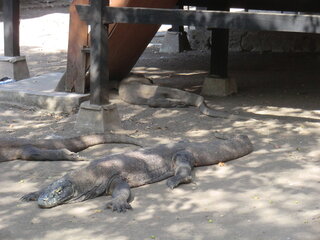
Soon after I arrived here, we took a trip to see the infamous Komodo dragons, not on the Komodo island, but on Rinca, which is an island nearly as big between Flores and Komodo. We arrived in the tiny harbour, where was already parked this big white sail Katharina, proud with her three masts. Once on land, a group of ranger was waiting calmly the next visitors and one of them took us to the entrance of the small village through a narrow path among the mangroves and the rocks. Just before the entrance, we crossed over this big salt marsh with small boards with names of people written on it. It turned out it wasn't the list of the people who died eaten by the dragons, but a new mangrove nursery with the names of the donors for the mangrove plants. The island is like the rest of the islands over here, a few patches of jungle in the middle, mangrove on the surrounding, and yellowish grass all over the rest, burnt by the sun. When we entered the village, which is just a few houses, a restaurant and a kitchen and some facilities, mostly for the rangers and the visitors passing by, we met our first dragons, which were, at the immense "surprise" of our guide, just down the kitchen. Laying flat, looking to sleep like stones, those dozens of dragons looked seriously lazy. And incredibly flat as well. Still, they sleep with only one eye closed; I don't know what would happen if you come close enough to them at that time, but after a while, you have this feeling that things might not be so quiet as they seem to be. Anyway, they do perfect still pose for the photos. Then, our guide, after a few warnings about the trek and all the dangers that might occur, with some stories of people being eaten a couple of days before, we started the short walk in the mountain. The air is very hot outside, perfect time to not see dragons, but somehow, I think everybody was expecting something to come out the bush in front of us and attack the ranger to have something to tell after. Anyway, after a while, passing in front of several former dragons' nests without seeing any "babies", some weird jungle trees and some locals wild animals (monkeys jumping in the palm trees and water buffalo covered with mud), we finally reach a little water pond, with very little muddy water (this is the dry season here), and a wild pig climbing up the slope, slowly fleeing us. The people from my group started then to look for another buffalo a bit farther away, but, still looking at this wild pig (how fascinating), I saw it suddenly looking on the right, and speeding up, it started to run in the other direction.
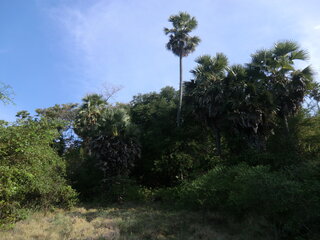
My over-developed brain asked me to then look on this right side, to discover a dragon coming up slowly, hidden in the grass, its snake tongue hissing to smell the odors of the surrounding. No wild pig carnage for today, but still, it was cool to see this dragon in the wild. Hopefully, I was looking at that pig, otherwise we would still watching that damn water buffalo. Our guide asked us if we would like to take some closer pictures, so I crossed the tiny stream with another girl and came closer to have a better look. I watched Jurassic Park dozens of times, so I knew everything about how raptors catch their preys and I was overlooking every corner of the trees to spot another dragon head in our back ready to attack us, but ah, I guess the ambush flopped and the dragon just went away, as slowly as it came. An hour after, we were already back to the village and back to the boat to go back to Kanawa. The trek was a bit short, but it was a long day, with two dives in the national park, and especially, we had to wait in the morning an hour and a half for the boat crew to take the boat away from the beach - it was parked near the shore for maintenance, but even after more than twenty years living in this area, they didn't figure out that the low tide would stick the boat on the beach in the morning.
http://www.youtube.com/watch?v=4mGz6sUIaEU
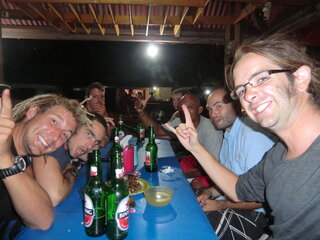
A couple of weeks later, we got our first real "day off" and using the excuse of going to the opening party of a new fashion beach-bar in this small remote town of Labuan Bajo, we all took the boat on Saturday afternoon to the continent (or so to say). The first we wanted to do once arrived was to eat proper food, everybody a bit sick of the restaurant on the island. We headed along the main road of Bajo in direction of the fish market along the second small harbor of the city, usually quite calm during the day, but now bustling with activities thanks to all the small restaurants opened along the docks. Guided by Chris who used to live in this city for a couple of months, we ended up in the first shop and ordered several fresh big fish (we ended up with a nice grouper for 50.000 rupiah, big enough for two people), which went directly to the grill near our table. Twenty minutes and several Bintang later, it arrived in big plate along with another one of white rice, and that was quite good. A couple of hours later, we left the place and took an ojek (a motorbike) to take us to our hotel, something big and fancy with comfy beds, balcony, hot shower and air-con, luxury that I never afforded since I started my trip, luxury more or less made for us foreigners anyway. After my first warm shower since... probably February, several Bintang less and a couple of arak drinks (nobody wants to know this one -_-), we finally headed up to the bar of Bajo, swimming pool, bean bags, expensive cocktails, lights and disco, and the lot of lady-boys. Definitively, this is not the same ambiance as the one on the island. At 1 o'clock, we were nearly the last ones and I took the last bemo with my instructor back to our hotel after an evening which would not stay in many memories anyway.
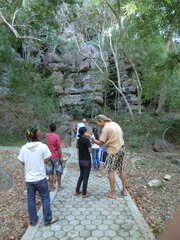
The next morning, not easy for everybody, we left the place to meet up with Dancy, Hanna and Fitri, who were working in Kanawa and had a day off as well, and some of their friends. We jumped in the bemo they rented for the day and headed up to one of the infamous "Bajo caves", probably the only sightseeing place in the surrounding, a 45 minutes ride away from the harbour, in the country side of Flores. Beside the driver, nobody really knew where we were heading to, but even if we didn't have a final destination, the only ride outside of the big city would have been worthwhile by itself: quickly, we exit the developed area of Bajo to end up in this country-side made of small houses, dusty side-walks and people waiting seemingly anywhere along the road to catch up a bemo passing by. It's a new face of Indonesia that I didn't know yet (no wonder), looking a bit similar to those places I just passed by when I was in Vietnam or Cambodia. Eventually, we reached the famous "cave", which are actually just that and not much more: a small house near the entrance to pay the entrance fee (damn, 30.000 rupiah for foreigners), a small paved walkway to the actual cave entrance, passing through the trees and some bamboo groves. After climbing some stairs leading to a crack in the cliff where tall trees reach for the light, we entered that hole in the rocks, crouching because it was quite narrow there. All the mobile phones were turned on to provide some lights, I was using the backlight from my camera to see where I was going to, taking some pictures sometimes with the flash at full power to have a very short overview of the place we were in (and it makes funny unexpected pictures at the same time...). Overall, it wasn't that impressive, but it was kind of cool anyway, getting lost in the dark, finding the way back, hitting my forehead on a stalactite I didn't see and bleeding for a while, looking for bats over our heads, playing hide-and-seek, looking for entrances-nobody-ever-found-before, taking surprise pictures in the dark, or just hanging out with different people.
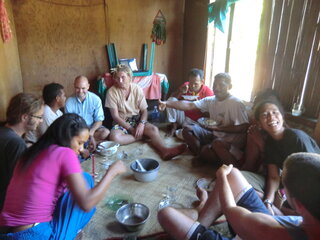
After a couple of hours, we got out of the place, everybody hungry. We jumped back in the bemo after sharing a glass of arak with the owners of the entrance house, and we headed to Hanna's house, where her family invited all of us to share the meal with them. Her house was in a remote place, at the end of a dirt road, small one-floored house full of people, uncles talking in the first room, aunts, sisters and mothers doing stuff in the back. It seems they weren't really expecting us so they sent one of the girl (Hanna's cousin?) to do some shopping nearby and she came back with some packs of noodles and eggs, and that was all for the lunch, quite simple but definitively appreciated by everybody. We all ate seated on the floor of the entrance room, everybody chatting together or taking pictures with my camera, or sharing the rest of the arak bottle we had. That was a short time, but that was really cool, a real escape from the place we are expected to be as foreigners. After a while, we flagged down another bemo all together with some people of Hanna's family, back to Bajo to found a new place to sleep, cheaper than our luxurious previous night. After visiting some sordid hotels smelling moistures and with enough mosquitoes in the room to catch malaria, paludism and a couple of other tropical disease in a matter of minutes, we found find a place OK. After dark, we got called by one of the girl to meet up on the harbour, where were packed thousands of Indonesian waiting to take the cheap every-two-weeks ferry between Lombok and Sulawesi and somehow, we managed to find them. They took us into a small speed-boat with a friendly driver who used to work in Kanawa before. We had no idea where we were going to, except we where going "on a boat" and after crossing Bajo's harbour, we ended up in one of those big live-aboard, and not any of those, but on Matahariku, which was, I have to say, just a beautiful boat, all made of wood, clean and cosy, with large bedrooms, proper deck and solarium, a big dining room with a large wooden table... and a few scuba tanks in the back of the boat, which make everyone of us wondering if we could have any chance of working there. But nothing happened this night, beside speaking a bit with the staff and hanging out on the deck at night, in the middle of Labuan Bajo's harbor, watching the big ferry taking place and loading up a few thousands souls.
http://www.youtube.com/watch?v=xYrqiHBpkSM http://www.youtube.com/watch?v=Q4_btBzgIKU
